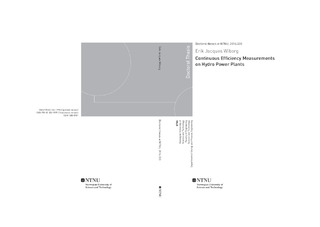| dc.contributor.advisor | Nielsen, Torbjørn | |
| dc.contributor.advisor | Kjeldsen, Morten | |
| dc.contributor.author | Wiborg, Erik Jacques | |
| dc.date.accessioned | 2017-01-18T09:27:40Z | |
| dc.date.available | 2017-01-18T09:27:40Z | |
| dc.date.issued | 2016 | |
| dc.identifier.isbn | 978-82-326-1999-3 | |
| dc.identifier.issn | 1503-8181 | |
| dc.identifier.uri | http://hdl.handle.net/11250/2427608 | |
| dc.description.abstract | In 2012 the largest Norwegian power production company Statkraft initiated a research and development project initially named BlackBox. The company’s main objective for the project was to develop an experimental condition monitoring system, later named HydroCord, tailored for Norwegian hydro power plants. Amongst the characteristics to be monitored, was the turbine efficiency.
The efficiency of the company’s turbines is generally measured every decade for the major power plants in Norway. This gives poor basis for any type of prediction of the future turbine state. Continuous efficiency measurements would enable efficiency trending, and combined with a prediction model would provide an estimate of the future optimal refurbishment time.
Another vital use of the turbine state is within production planning, where it would enable a more regular and frequent update of the production model.
During this PhD work, Trollheim power plant has been the site for design, construction and testing of the HydroCord pilot system. The full system consists of a substantial number of miscellaneous measurements. The produced data is collected through five hubs spread out from the reservoir to the power plant outlet. The data is transferred between the hubs by fibre to a server, processing and storing the data. This project was led by the author of this thesis.
The focus of the PhD work was to establish a working method for continuous efficiency measurement, to be implemented in the HydroCord system. Three important issues had to be addressed. The design of an automated data validation method, its capability to reduce the high uncertainty caused by oscillations in the data, and the choice of the measurement method at site.
To prevent regulation from interfering with the efficiency measurement, which requires steady state measurements, a three-step automated quality control method was successfully designed and tested. The three steps consisted of a steadiness check, a normality check and a surge extraction process. The focus of the method was to reject any fluctuating measurements in order to ensure a good quality monitoring of the efficiency.
Simultaneously, the three-step method had to deal with potential mass oscillations in the waterways. This was done by numerically filtering the measured data, once the existence of such a surge was confirmed by the method. The reason for the filtering was to reduce the uncertainty of the measured values.
A measurement method based on the acoustic transit time flow measurement method was selected for the HydroCord continuous efficiency measurement. Field efficiency measurements are generally entirely focused on low uncertainty of measurement. For automated field efficiency measurements, the focus had to be divided between a good accuracy, a reasonable cost and minimizing the chances of potential production interruption. Different efficiency measurement methods were tested and compared focusing on the flow measurement component of the efficiency measurement. The study and field tests revealed that a continuous efficiency measurement based on a clamp-on acoustic transit time flow measurement provided the results with the lowest uncertainty and a set-up in accordance with the requirements mentioned above.
By combining the steadiness control, the uncertainty reduction and a studied choice of measurement method, all elements required for the final design and installation of a continuous efficiency measurement system at Trollheim Power Plant are now in place. | nb_NO |
| dc.language.iso | eng | nb_NO |
| dc.publisher | NTNU | nb_NO |
| dc.relation.ispartofseries | Doctoral theses at NTNU;2016:330 | |
| dc.relation.haspart | Paper 1: Wiborg, Erik Jacques; Hulaas, Harald; Francke, Håkon Hjort; Nielsen, Torbjørn Kristian. Applied statistical quality control on field measurement data. IGHEM 2014 | nb_NO |
| dc.relation.haspart | Paper 2: HydroCord Condition Monitoring System | nb_NO |
| dc.relation.haspart | Paper 3: Continuous Efficiency Measurements on Hydro- Power Turbines A Comparison Between Acoustic Clamp-on Flow Measurement and the Winter-Kennedy Index Method | nb_NO |
| dc.title | Continuous Efficiency Measurements on Hydro Power Plants | nb_NO |
| dc.type | Doctoral thesis | nb_NO |
| dc.subject.nsi | VDP::Technology: 500::Environmental engineering: 610 | nb_NO |
